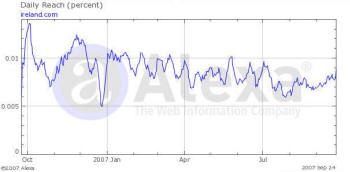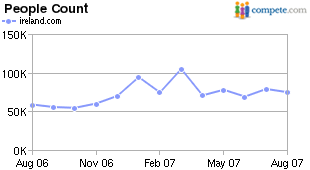eoghan posted on September 30, 2007 17:15
 September 29th marked the six month anniversary of the launch of the Irish Times blog section. The first of their blogs to go live was Jim Carroll's On The Record (the first entry of which was posted on March 29th). The Present Tense, Pricewatch and Correspondant blogs soon followed, although the latter of these was only active until shortly after the General Election.
September 29th marked the six month anniversary of the launch of the Irish Times blog section. The first of their blogs to go live was Jim Carroll's On The Record (the first entry of which was posted on March 29th). The Present Tense, Pricewatch and Correspondant blogs soon followed, although the latter of these was only active until shortly after the General Election.
Thankfully, from the off, the decision was taken to not lock the blogs up behind the 'Premium content' wall that cuts off most of the Irish Times website. If they had been, the blogs certainly would not have seen the success nor secured the extensive visibility they have in the Irish blogosphere. On the Record in particular has made its mark as a must visit blog for anyone in Ireland with a healthy interest in the music scene and industry.
The success of these blogs however is not just reflected in the number and quality of informative blog entries (and it must be said equally informative comments left on the blogs) but also in the raw numbers of links the blogs have attracted in this short space of time. When it comes to the interweb it is the links your site (or blog) manages to attract from others that plays a vital role in making or breaking your site. So how can you measure the number of links a site (or an individual page on a site) has received? Yahoo's "Site Explorer" tool is widely accepted by those with an interest in such matters as being the most accurate tool to do so. At the time of writing this tool throws up the following number of links from other websites ("Inlinks") that each Irish Times blog has attracted:
This adds up to total of 73,307 inlinks, an impressive enough figure on its own. But even more so when you consider that, over its 8 or so year life, the entire Ireland.com website has managed to attract a total of 525,745 inlinks. In a nutshell the blogs, in the space of six months, now attract over 14% of all links to Ireland.com.
All this new 'link love' is going to have a consequence for the blogs, and for the other freely accessible, non-premium parts of the site. I'm over-simplifying here but, in effect, thanks to this 'link love' pages on these blogs can expect to rank more highly on search engines for relevant key word searches than many other similar pages recieving less link love. In addition the 'link love' will be seen by the search engines to 'leak' to other (non-premium parts) of the Ireland.com site raising the potential of those pages to rank more highly in search engine result pages.
The consequence of this? Well for one, an increase in the number of visits referred to Ireland.com by the search engines. I'll stick my head out a bit and venture that the Ireland.com backroom geek team - if they have their eye on the ball - is already seeing this happen. And in 2007 more visits from the search engines mean you can serve up more advertisements, meaning more moolah to be made.
It is this exact cycle that recently made the NY Times realise that charging for access to certain parts of their website meant they were actually losing money. Big time. Hence their decision to drop their premium pay-to-read sections. Their entire site – including their archives – is now totally now free to browse.
Ireland.com however seems to be going in the other direction. They don't just continue to insist you pay to access the vast majority of articles (EUR 79 a year to access the last 10 years of articles), but they have also gone and introduced a new 'Premium Plus' subscription (for a whopping EUR 395 a year) to access their full archive dating back to 1859.
Asking your readers to pay to access content is soooo 2001. It is simply no longer a growth industry. The growth curve now lies with online advertising which is becoming (if it is not already) the primary source of potential revenues for non e-commerce websites. And if you choose to lock up 99% of your content behind pay-walls (as Ireland.com do) you are also making an active choice to restrict your ability to pull in the (growing) online advertising revenues out there.
 My guess is that in recent years Ireland.com was not seeing much growth in their basic subscription revenues and they did the opposite of what they should have - they introduced yet another premium service (the 359 euro a year 'Premium Plus' product) in the hope it would grow their income and get them out of the loss making situation they are in (EUR 180,000 loss in 2006). Indeed publicly available tools for measuring the popularity of websites (such as Alexa.com or Compete) show that over the last 12 months the full Ireland.com site (see Alexa data in the first graph, Compete.com data in second graph below) has not been a period of explosive growth. The success of the blogs has itself not been enough to reverse the tide (yes, yes, I am fully aware that these tools are not perfectly accurate, but for the purposes of this discussion they, together, can be taken as a strong indication of traffic trends).
My guess is that in recent years Ireland.com was not seeing much growth in their basic subscription revenues and they did the opposite of what they should have - they introduced yet another premium service (the 359 euro a year 'Premium Plus' product) in the hope it would grow their income and get them out of the loss making situation they are in (EUR 180,000 loss in 2006). Indeed publicly available tools for measuring the popularity of websites (such as Alexa.com or Compete) show that over the last 12 months the full Ireland.com site (see Alexa data in the first graph, Compete.com data in second graph below) has not been a period of explosive growth. The success of the blogs has itself not been enough to reverse the tide (yes, yes, I am fully aware that these tools are not perfectly accurate, but for the purposes of this discussion they, together, can be taken as a strong indication of traffic trends).
 Thankfully for Ireland.com they also decided to try out a bit of blogging outside of their 'pay wall'. In doing so they managed - as we have seen - to attract a huge number of links, not just attracting a new set of visitors to the blogs but also, I am sure, increasing the ranking of of Ireland.com pages (but only the 1 or so % of pages that are 'non-premium') in search engine result pages. In the right hands this translates into potentially very serious increased revenues. Imagine however the links (i.e. traffic, hence ad revenue) they could generate if all their content - not just 1% - was free to access?
Thankfully for Ireland.com they also decided to try out a bit of blogging outside of their 'pay wall'. In doing so they managed - as we have seen - to attract a huge number of links, not just attracting a new set of visitors to the blogs but also, I am sure, increasing the ranking of of Ireland.com pages (but only the 1 or so % of pages that are 'non-premium') in search engine result pages. In the right hands this translates into potentially very serious increased revenues. Imagine however the links (i.e. traffic, hence ad revenue) they could generate if all their content - not just 1% - was free to access?
Bottom line? Ireland.com has more to benefit by going subscription-free than it does hiding behind a pay wall. My guess? The wall will be dismantled within 6 months. Hopefully Hotpress.com will also see the light and drop their insistence on paying to access hotpress.com content.
More ...
[Read More...]